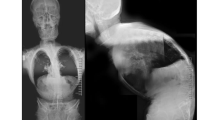Abstract
Purpose
To analyze the role of spine alignment in post-traumatic paraplegic patient as a potential cause of late Charcot spine disease (CSD).
Method
A retrospective review of three cases in which the disease appeared more than 15 years after a spinal cord injury treated by posterior fusion. A review of the literature concerning spine balance in sitting position, especially referred to paraplegic patients, is done to validate this hypothesis.
Results
Lumbar kyphosis in paraplegic patients during the sitting position may increase the mechanical load on disks and ligament below the previously fused area. This phenomenon, in combination with lack of protective mechanism because of poor muscular support and lack of sensitivity can speed up and amplify the normal degenerative changes in the disk and ligaments.
Conclusions
More investigations are required to fully understand all the mechanisms underlying CSD pathogenesis to prevent it. Until then, a systematic long-term clinical and radiological follow-up in all post-trauma paraplegic patients is suggested. Combined anterior and posterior fusion, when feasible, can restore the sagittal balance providing a better quality of life in these patients.





Similar content being viewed by others
References
Barrey C, Massourides H, Cotton F, Perrin G, Rode G (2010) Charcot spine : two new case reports and a systematic review of 109 clinical cases from the literature. Ann Phys Rehabil Med 53:200–220
Vaccaro AR, Silber JS (2001) Post-traumatic spinal deformity. Spine 26(24s):111–118
Standaert C, Cardenas DD, Anderson P (1997) Charcot spine as a late complication of traumatic spinal cord injury. Arch Phys Rehabil Med 78:221–226
Devlin VJ, Ogilvie JW, Transfeldt EE, Boachie-Adjei O, Bradford DS (1991) Surgical treatment of neuropathic spinal arthropathy. J Spinal Disord 4:319–328
Lazennec JY, Brusson A, Rousseau MA (2013) Lumbar-pelvic-femoral balance on sitting and standing lateral radiographs. Orthop Traumatol Surg Res 99(Suppl 1):S87–103
Seelen HAM, Potten YJM, Huson A, Spaans F, Reulen JPH (1997) Impaired balance control in paraplegic subjects. J Electromyogr Kinesiol 7:149–160
Janssen-Potten YJ, Seelen HA, Drukken J, Huson T, Drost MR (2001) The effect of seat tilting on pelvic position, balance control, and compensatory postural muscle use in paraplegic subject. Arch Phys Rehabil Med 82:1393–1402
Karadimas EJ, Siddiqui M, Smith FW, Wardlaw D, Orth F (2006) Positional MRI changes in supine versus sitting postures in patients with degenerative lumbar. J Spinal Disord Tech 19:495–500
Lee ES, Ko CW, Suh SW, Kumar S, Kang IK, Yang JH (2014) The effect of age on sagittal plane profile of the lumbar spine according to standing, supine, and various sitting positions. J Orthop Surg Res 9:1–10
Bishop FS, Dailey AT, Schmidt MH (2010) Massive Charcot spine disease deformity presenting with increasing abdominal girth and discomfort. Neurosurg Focus 28(3):1–3
Selmi F, Frankel HL, Kumaraguru AP, Apostopoulos V (2002) Case report Charcot joint of the spine, a cause of autonomic dysreflexia in spinal cord injured patients. Spinal Cord 40:481–483
Morita M, Iwasaki M, Okuda S, Oda T, Miyauchi A (2010) Autonomic dysreflexia associated with Charcot spine following spinal cord injury: a case report and literature review. Eur Spine J 19s:179–182
Suda Y, Shioda M, Kohno H, Machida M (2007) Surgical Treatment of Charcot Spine. J Spinal Disord Tech 20(1):85–88
Vialle R, Mary P, Tassin J, Parker F, Guillaumat M (2005) Charcot’s Disease of the Spine. Spine 30:315–322
Morita M, Miyauchi A, Okuda S, Oda T, Yamamoto T, Iwasaki M (2008) Charcot spinal disease after spinal cord injury. J Neurosurg Spine 9:419–426
Kim T, Seo E, Hwang J, Kwak B (2005) Charcot spine treated using a single staged posterolateral costotransversectomy approach in a patient with traumatic spinal cord injury. J Korean Neurosurg Soc 54:532–536
Hong J, Sanfilippo JA, Rihn J, Fernandez C, Winegar CD, Friel B, Ludwig S, Gelb D, Vaccaro AR (2009) Complications in the management of chrcot spinal arthropaty. J Neurosurg Spine 11:236–368
Hastings JD, Fanucchi ER, Burns SP (2003) Wheelchair Configuration and Postural Alignment in Persons With Spinal Cord Injury. Arch Phys Med Rehabil 84:528–534
Conflict of interest
None.
Author information
Authors and Affiliations
Corresponding author
Rights and permissions
About this article
Cite this article
De Iure, F., Chehrassan, M., Cappuccio, M. et al. Sitting imbalance cause and consequence of post-traumatic Charcot spine in paraplegic patients. Eur Spine J 23 (Suppl 6), 604–609 (2014). https://doi.org/10.1007/s00586-014-3550-1
Received:
Revised:
Accepted:
Published:
Issue Date:
DOI: https://doi.org/10.1007/s00586-014-3550-1




